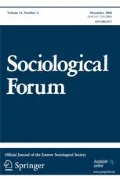Abstract
Most theory and research on organizations assumes that the great diversity of organizational attributes reflects variation in implementation of a relatively small number of forms. Modern conceptions of organizational form concentrate on discontinuities in distributions of either attributes or relationships with other organizations. We argue that this approach be supplemented with an explicitly dynamic one that focuses on processes that create and erode boundaries in the organizational world. This paper discusses some of the advantages of this approach and specifies a number of processes that create and erode boundaries around organizational populations.
Similar content being viewed by others
References
Aldrich, Howard 1979 Organizations and Environments. Englewood Cliffs, NJ: Prentice Hall.
Averitt, Robert T. 1968 The Dual Economy. New York: W. W. Norton.
Baron, James N. andWilliam T. Bielby 1984 “The organization of work in a segmented economy.” American Sociological Review 49:454–473.
1956 “Ecological relationships of ethnic groups in Swat, North Pakistan.” American Anthropologist 58:1079–1089.
1969 Fredrik Barth (ed.), Ethnic groups and boundaries:9–38. Boston: Little Brown.
Becker, Howard S. 1982 Art Worlds. Berkeley, CA: University of California Press.
Brittain, Jack andJohn Freeman 1980 “Organizational proliferation and density-dependent selection.” In John Kimberly and Robert Miles (eds.), Organizational Life Cycles:291–338. San Francisco: Jossey-Bass.
Burawoy, Michael 1979 Manufacturing Consent: Changes in the Labor Process Under Monopoly Capitalism. Chicago: University of Chicago Press.
Burns, Tom andGeorge M. Stalker 1961 The Management of Innovation. London: Tavistock.
1983 “A stochastic model of organizational mortality: Review and reanalysis.” Social Science Research 12:303–329.
1984 “Organizational ecology.” Annual Review of Sociology 10:71–93.
Conte, Christopher 1983 “Deregulation of banks stirs confusion, splits Fed and White House.” Wall Street Journal, 1 July.
Delacroix, Jacques andGlenn R. Carroll 1983 “Organizational founding: An ecological study of the newspaper industries of Argentina and Ireland.” Administrative Science Quarterly 28:274–291.
DiMaggio, Paul forthcoming “Structural analysis of organizational fields: A blockmodel approach.” In B. Staw and L. Cummings (eds.), Research in Organizational Behavior. Westwood, CT: JAI Press.
DiMaggio, Paul andWalter W. Powell 1983 “The iron cage revisited: Institutional isomorphism and collective rationality in organizational fields.” American Sociological Review 48:147–160.
Freeman, John 1985 “Entrepreneurs as organizational products.” Unpublished manuscript.
Freeman, John andMichael T. Hannan 1983 “Niche width and the dynamics of organizational populations,” American Journal of Sociology 88:1116–1145.
Gordon, David M., Richard Edwards, andMichael Reich 1982 Segmented Work, Divided Workers: The Historical Transformation of Labor in the United States. Cambridge: Cambridge University Press.
1979 “The dynamics of ethnic boundaries in modern states.” In John W. Meyer and Michael T. Hannan (eds.), National Development and the World System:253–275. Chicago: University of Chicago Press.
Hannan, Michael T. forthcoming Uncertainty, diversity, and organizational change.” In Neil Smelser and Dean R. Gerstein (eds.), Knowledge in Social and Behavioral Science: Discoveries and Trends over Fifty Years. Washington, DC: National Academy of Sciences.
1977 “The population ecology of organizations.” American Journal of Sociology 82:929–964.
1978 “Internal politics of growth and decline.” In M. Meyer et al. (eds.), Environments and Organizations. San Francisco: Jossey Bass.
1984 “Structural inertia and organizational change.” American Sociological Review 49:149–164.
Hannan, Michael T. and John Freeman 1985 “Ecology of organizational founding rates: Dynamics of foundings of American labor unions, 1836–1985.” Unpublished manuscript.
Hodson, Randy andRobert L. Kaufman 1982 “Economic dualism: A critical review.” American Sociological Review 47:727–739.
Kaufman, Robert L., Randy Hodson, andNeil D. Fligstein 1981 “Defrocking dualism: A new approach to defining industrial sectors.” Social Science Research 10:1–31.
Lorrain, Francois P. andHarrison C. White 1971 “Structural equivalence of individuals in social networks.” Journal of Mathematical Sociology 1:49–80.
McKelvey, Bill 1982 Organizational Systematics. Berkeley: University of California Press.
McKelvy, Bill andHoward Aldrich 1983 “Populations, natural selection and applied organizational science.” Administrative Science Quarterly 28:101–128.
McPherson, Miller 1983 “An ecology of affiliation.” American Sociological Review 48:519–532.
Meyer, John W. 1983 “Institutionalization and the rationality of formal organizational structure.” In John W. Meyer and W. Richard Scott (eds.), Organizational Environments: Ritual and Rationality:261–282. Beverly Hills, CA: Sage.
Meyer, John W. andW. Richard Scott, eds. 1983 Organizational Environments: Ritual and Rationality. Beverly Hills, CA: Sage.
Monod, Jacques 1971 Chance and Necessity. New York: Vintage.
1983 “Contemporary ethnic mobilization.” Annual Review of Sociology 9:355–374.
Olzak, Susan forthcoming “A competition model of ethnic collective action in American Cities 1877–1889.” In S. Olzak and J. Nagel (eds.), Competitive Ethnic Relations, New York: Academic Press.
1965 Social structure and organizations. In James G. March (ed.), Handbook of Organizations:153–193. Chicago: Rand McNally.
1968 Constructing Social Theories. New York: Harcourt Brace.
1983 Economic Sociology. New York: Academic Press.
Thompson, James D. 1967 Organizations in Action. New York: McGraw-Hill.
Tuma, Nancy Brandon andMichael T. Hannan 1984 Social Dynamics: Models and Methods. New York: Academic Press.
Wallace, Michael andArne L. Kalleberg 1981 Economic organization, occupations, and labor force consequences: Toward a specification of dual economy theory. In Ivar Berg (ed.), Sociological Perspectives on Labor Markets:77–177. New York: Academic.
Weber, Max 1968 Economy and Society: An Outline of Interpretive Sociology. 3 vols. New York: Bedmeister.
White, Harrison 1963 An Anatomy of Kinship. Englewood Cliffs, NJ: Prentice Hall.
1976 “Social structure from multiple networks: I. blockmodels of roles and positions.” American Journal of Sociology 81:730–780.
1981 “Where do markets come from?” American Journal of Sociology 87:517–547.
1975 Markets and Hierarchies. New York: Free Press.
1981 “The economics of organization: The transaction cost approach.” American Journal of Sociology 87:548–577.
Woodward, Joan 1965 Industrial Organization: Theory and Practice. London: Oxford University Press.
Author information
Authors and Affiliations
Rights and permissions
About this article
Cite this article
Hannan, M.T., Freeman, J. Where do organizational forms come from?. Sociol Forum 1, 50–72 (1986). https://doi.org/10.1007/BF01115073
Issue Date:
DOI: https://doi.org/10.1007/BF01115073




